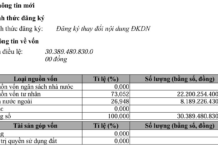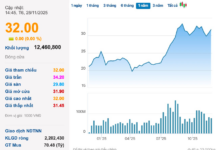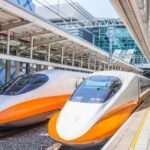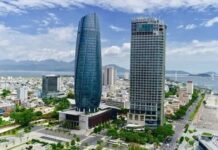
The proposed North-South high-speed railway will have a speed of 350 km/h, covering a distance of 1,541 km – Illustration
In late July 2024, Prime Minister Pham Minh Chinh chaired a meeting on law building. After discussing the proposal for the investment policy of the high-speed railway on the North-South axis, the Government members basically agreed on the policy to submit it to the competent authority for consideration and decision.
Accordingly, the country’s first high-speed railway will be 1,541 km long, with a plan to complete it by 2035, combining economics with security and national defense, mainly passenger transport, and cargo transport when needed.
Ripe Timing
Talking to the Government Portal, Deputy Minister of Transport Nguyen Danh Huy said: “For over 18 years, the Ministry of Transport has conducted many studies with the support of organizations and consultants at home and abroad.”
Following Conclusion No. 49-KL/TW of the Politburo, the Ministry of Transport has drawn lessons from international experiences and assessed specific conditions in Vietnam.
Through coordination with ministries, sectors, and concerned agencies, careful and thorough analysis and evaluation of transport functions, speed and axle load selection, localization capacity, technology ownership, investment roadmap, resource mobilization capacity, and investment efficiency, the Ministry of Transport proposed constructing the high-speed railway on the North-South axis with a design speed of 350 km/h, mainly for passenger transport (cargo transport when necessary). The total length of the route is about 1,541 km, double-track, standard gauge of 1,435 mm, and electrification. The total investment is estimated at 65-70 billion USD.
It is expected that the project will be submitted to the competent authority for approval, and the investment project will be started before 2030, striving to complete the entire route before 2040.
“I think that with Vietnam’s current position and potential, the timing for investing in high-speed railways is ripe. Having a high-speed railway is a legitimate aspiration of any nation and people, aiming to bring transportation infrastructure to new heights of modernity and civilization, meeting the needs of the people and the economy,” said Deputy Minister Huy.
Regarding the balancing of resources to invest in the high-speed railway, the Deputy Minister of Transport said: “If we are truly determined to have a dynamic and strategic project that creates new development space, efficiently utilizes resources, and lays the foundation for a developing country with high income, with our current economic potential and scale, resources are no longer a big challenge.”
The Ministry of Transport is coordinating with relevant agencies to assess the situation. Preliminary results show that the public debt indicator is within the allowable limit, and some other indicators do not increase much compared to the scenario without investing in the project.
However, if we consider the project’s contribution to GDP growth during the construction period (about 0.97 percentage points/year, according to the calculation of the Ministry of Planning and Investment) and the revenue from land fund exploitation in TOD (Transit-Oriented Development) areas and commercial exploitation (expected to be about 22 billion USD), these indicators will be improved.
According to the Ministry of Transport, studies from some countries with well-developed high-speed railway networks show that Japan decided to invest in its first high-speed railway in 1950 when its GDP per capita was only about 250 USD. China joined the game in 2005 when its GDP per capita reached 1,753 USD, while Indonesia invested in 2015 with a GDP per capita of 3,322 USD.
In Vietnam, according to the World Bank’s research, it is now an appropriate time to build a high-speed railway when the country’s GDP per capita reached about 4,282 USD in 2023 and is estimated to reach about 7,500 USD in 2030.
The economy’s scale in 2023 was about 430 billion USD, nearly triple that of 2010, while public debt was at a low level, at about 37% of GDP. By the time of the high-speed railway construction in 2027, the economy’s scale is forecast to reach about 564 billion USD, so resource mobilization is no longer a significant obstacle.
Hanoi-Vinh and Ho Chi Minh City-Nha Trang Sections to Start in Late 2027
According to Mr. Chu Van Tuan, Deputy Director of the Railway Project Management Board (under the Ministry of Transport), in the past time, the Ministry of Transport has actively studied experiences and referred to models from 22 countries and territories, and learned from six countries that own and master high-speed railway technology.
Through careful and thorough research with the support of domestic and foreign organizations, the North-South high-speed railway is proposed to be invested in with a double-track, standard gauge of 1,435 mm, electrification, and an infrastructure design speed of 350 km/h.
The route will start from Ngoc Hoi Station (Hanoi), passing through 20 provinces and cities and ending at Thu Thiem Station, Ho Chi Minh City. The entire route will have 23 passenger stations with an average distance of about 67 km and five freight stations associated with major cargo hubs.
Based on that, the Ministry of Transport has proposed concentrating resources to start the Hanoi-Vinh and Ho Chi Minh City-Nha Trang sections, with a total length of about 642 km, in late 2027. The Vinh-Nha Trang section (about 899 km long) will be started before 2030, striving to complete the entire route by 2035.
‘Have Breakfast in Hanoi and Lunch in Ho Chi Minh City’
Regarding the reason for choosing a speed of 350 km/h or higher instead of a lower speed to save costs, Mr. Chu Van Tuan said that a speed of 350 km/h or higher and an average station distance of 50-70 km is a world trend and is considered suitable and effective. With this speed, the travel time between Hanoi and Ho Chi Minh City will be significantly reduced to only 5 hours and 30 minutes.
Also, according to calculations, the investment cost of a 350 km/h speed is about 8-9% higher than that of a 250 km/h speed, but it is more attractive and thus more efficient. If investing in a 250 km/h speed, it will be challenging to upgrade to 350 km/h later.
As a railway expert, Mr. Nguyen Ngoc Dong, former Deputy Minister of Transport, said that a train speed of 350 km/h would offer more options for organizing train operations. Thus, on the Hanoi-Ho Chi Minh City route, the train could run for about 5.5-6 hours or more than 10 hours. Passengers can choose the train that suits their needs.
Conversely, if the design speed is 250 km/h, the operating speed will be lower, a maximum of about 80% of the design speed, and the travel time on the same route will take more than 10 hours. With this travel time, passengers will prefer air transport.

High-speed train running on the Tunchen Bay Bridge in China on August 31, 2023 – Photo: China State Railway Group Co., Ltd.
Many localities hope for an early high-speed railway
As shared by Deputy Minister of Transport Nguyen Danh Huy, “having a high-speed railway is a legitimate aspiration of any nation and people, aiming to bring transportation infrastructure to new heights.” Recently, on August 1, in Da Nang city, the working group of the Socio-Economic Sub-Committee (of the 14th National Party Congress) worked with the Northern Central and Coastal Central provinces and cities on regional planning. Leaders of the provinces and centrally-run cities proposed an early investment in the high-speed railway for convenient travel and socio-economic development in the localities.
Mr. Nguyen Van Quang, Secretary of the Da Nang Party Committee, said that it is necessary to frankly propose to the National Assembly to approve the development of a high-speed railway connecting localities in the region. Because traveling within the Northern Central and Coastal Central regions is very difficult, and flight options are limited. Currently, the region is building a system of high-speed roads, but to develop tourism and promote faster development, there must be a high-speed railway, and it should be divided into sections and routes for investment.
“Recently, when flights were disrupted, Da Nang’s tourism benefited from the use of trains for passenger transport, specifically the Hue-Da Nang route. If we want to focus on developing the region, we must have a high-speed railway,” said Mr. Quang.
According to Mr. Do Minh Tuan, Chairman of the People’s Committee of Thanh Hoa province, infrastructure development must break through transportation, striving to have a North-South high-speed railway. The current high-speed roads need to be completed and invested synchronously because some sections have six lanes, while others have only four lanes.
Sharing the same view, Mr. Thai Thanh Quy, Secretary of the Provincial Party Committee and Chairman of the Provincial People’s Council of Nghe An province, said that it is necessary to soon invest in a high-speed railway. At the same time, it is necessary to pay great attention to the transverse routes connecting the East and the West to enhance connectivity between localities, regions, and the whole country.
60 years since its inception, high-speed railways have developed in 22 countries and territories, with nearly 60,000 km in operation and about 20,000 km under construction.
China has achieved breakthrough development in this field. In just 15 years (from 2005 to 2020), China has built more than 40,000 km of high-speed railways, accounting for more than 2/3 of the world’s total length. After putting into operation the Beijing-Shanghai high-speed railway, 1,318 km long, with a speed of 380 km/h and an investment value of 33 billion USD (in 2011), about 1.7 billion passengers in China have traveled on this route, creating more than 850 million jobs. Land prices in the project areas increased by up to 13%, especially in areas adjacent to stations. The number of tourists visiting famous destinations increased by more than 2.5 times.
With a punctuality rate of 99.9%, safety, and environmental friendliness, high-speed railways have made a significant contribution to Japan’s miraculous development through the redistribution of urban areas, population, and convenient transportation, creating jobs, and promoting economic development.
Spain has nearly 4,000 km of high-speed railways, ranking first in Europe and second in the world. The operating speed of 250-320 km/h has helped reduce travel time between regions by an average of 27%.
“High-Speed Rail Project: Presenting the Vision for a 350km/h North-South Corridor in Vietnam”
The Vietnam Railways Authority has confirmed that the Ministry of Transport has submitted a proposal for a high-speed North-South railway to the Government Party Committee for approval by the Politburo. The Ministry is expediting the completion of the project’s pre-feasibility study report, aiming to present it to the National Assembly for their consideration and investment decision during their upcoming October session.
“Architect Trần Ngọc Chính: Saigon – Tay Ninh is a Crucial Economic and Tourism Corridor, Saigon’s Masterplan Must Prioritize the Saigon River as its ‘Backbone’”
KTS Trần Ngọc Chính, former Deputy Minister of Construction and Chairman of the Vietnam Urban Development Planning Association, envisions a vibrant “bến dưới thuyền” (a bustling waterfront) along the Saigon River corridor. He proposes the development of a premium tourism infrastructure axis and a modern transportation network, including river, road, and rail connections linking Ho Chi Minh City, Cu Chi, Nui Ba Den, and Tay Ninh. This, he believes, will create a dynamic and vibrant waterfront atmosphere, mirroring the success of major cities around the world.
The High-Speed Rail Project: Unveiling China’s Giant Involvement in Vietnam’s Transportation Revolution
With an impressive track record in Vietnam, the company has successfully undertaken over 30 projects, amassing a total contract value of more than $3 billion.












































